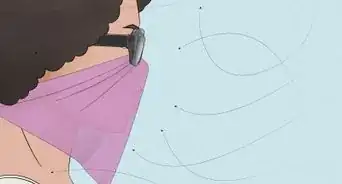This article was co-authored by Andrew Carberry, MPH. Andrew Carberry is a Food Systems Expert and the Senior Program Associate at the Wallace Centere at Winrock International in Little Rock, Arkansas. He has worked in food systems since 2008 and has experience working on farm-to-school projects, food safety programs, and working with local and state coalitions in Arkansas. He is a graduate of the College of William and Mary and holds a Masters degree in public health and nutrition from the University of Tennessee.
wikiHow marks an article as reader-approved once it receives enough positive feedback. In this case, several readers have written to tell us that this article was helpful to them, earning it our reader-approved status.
This article has been viewed 221,654 times.
Ivy plants can quickly overrun gardens, roadsides, trees and even house walls. Many ivy plants are invasive in some climates, including the Hedera helix (English ivy) cultivars "Pittsburgh," "Star," and "Baltica," and the related species Hedera hibernica (Atlantic ivy). Many people prune ivy regularly, a necessary step to ensure it does not remove brickwork, windows or other structures. Whether you want to remove a little or a lot, keeping ivy at bay is a necessary task explained in the proceeding steps.
Steps
Removing Ivy from the Ground (Ivy Deserts)
-
1Prepare yourself for the job. If you’re working on uncovering a large area of land, you will likely require the help of 2-3 people in the process. You each will need pruning shears or a hacksaw to cut through the largest vines and roots.
-
2Locate the edges of the ground-cover. Ivy grows outwards and can quickly spread to cover a large portion of the ground, easily growing over other plants and objects. A large area completely covered in ivy, typically in a shaded section of land, is called an ivy desert. The first step is to find the edges of this area, and making note of any large plants the ivy covers in the interior of the section.Advertisement
-
3Cut the root systems at the edges. Use a pair of pruning shears and work your way around the ivy desert, cutting through the thickest branches and roots. If the area you are working with is quite large, cut through it in smaller sections so that you don’t have to work with so much space at once.[1]
-
4Roll up the ivy into ‘logs’. Stand shoulder-to-shoulder next to your volunteer helpers, and begin to roll the ivy as if it were a giant mat into a log shape. Continue rolling until the entire area of ground has been exposed, and all the ivy is contained within the roll. Depending on the size of the land you’re working on, you may have to create several logs of ivy to carry out.[2]
-
5Carry out the ivy. Ivy can still re-root itself in the ground even when it has been cut off, so remove the ivy logs you’ve just rolled from the premises. You can dispose of these in a safe place later, after you’ve made sure the ground is ivy-free.
-
6Double-check the area for remaining ivy. As aforementioned, it doesn’t take much ivy to start another huge patch. Before heading off in confidence with your ivy logs, be sure to take a few minutes to review the weeded area. Pick up any remaining ivy, and cut/pull out the roots if they are visible.
-
7Cover the ground. A layer of mulch will discourage new ivy from taking hold. To make the vine's comeback even less likely, plant less invasive shade-loving plants such as hostas.
Removing Ivy from Trees
-
1Determine the extent of coverage. Large spreads of ivy can quickly swallow up whole trees, and kill them off by choking off their roots. Check your tree to determine its health, and how much of it is covered by ivy. Depending on the amount, it may be too damaged to save and may need to be removed along with the ivy.
-
2Select the area of ivy to be removed. Thankfully, it is not necessary to remove all of the ivy on a tree in order to kill it off. The root system of the ivy is in the ground, so you only have to remove the bottom-most section of ivy to control it. The rest will eventually die. If there is little enough, you may be better off pulling out all the ivy. If your tree is nearly engulfed, measure out a space about 4–5 feet (1.2–1.5 m) high from the roots of the tree up the trunk, and outwards in a radius of about 3 feet (0.9 m) on the ground.
-
3Cut off the ivy at the base of the trunk. Use a pair of gardening shears or a small hacksaw to cut away at the ivy in sections around the base of the tree. It will take a bit of elbow grease to get it all pulled away from the tree, and there will probably be pieces that break off from the roots, but don’t worry about it just yet. Focus on getting the majority of the ivy off from the roots and trunk of the tree.[3]
-
4Cut the ivy again at a higher level. Go around the tree a second time with your shears, this time severing ivy vines at the highest point you can safely reach. Tear the cut sections off the tree. This will ensure that you haven't missed any vines, and minimize the fire hazard from dead vines.
-
5Remove remaining ivy. With the majority of the ivy removed, make your way around the tree and pull off any smaller pieces or intact roots that you see. This will prevent the ivy from growing back and filling in the space you just cleared.
-
6Dispose of the ivy. Carry the ivy you pulled away from the area, and store it in a dry, flat area (on rocks or concrete is best) until you can destroy the plant.[4]
Removing Ivy from Walls and Fences
-
1Prepare your supplies. Removing ivy from structures can be a bit tricky, as you don’t want to damage your walls/fences in the process of removal. You will mostly use your hands, but will also need gloves, garden shears, a hose/water, a wire brush, and dish detergent or weed killer.
-
2Make the ivy easier to remove. Start by hosing down the ivy with a bit of water, as this will soften the vines and roots a bit in order to make them easier to pull off. When you begin to remove the ivy, start from the top and work your way down, as this will give more time for the water to soak into the thicker vines near the bottom and make tugging easier for you.[5]
-
3Begin pulling the ivy off your structure. In order to prevent damage to your fence/building, use only your hands to gently tug the ivy away. If you come to a strong or thick vine of the ivy, use your gardening shears to snip it and then pull it off using your hands. Be as gentle as you can, because if you pull the ivy too hard it is likely to remove some of the wood or brick/mortar that is supporting your structure.
-
4Brush off the remaining ivy. When you’ve gotten all of the largest sections of ivy, including the vines and leaves, pulled off of your structure, you can use your stiff bristle or wire brush to scrape off the small tendrils the plant may have left behind. Use a dry brush to start, and wipe away as much of the plant as you are able.
-
5Wash off your structure. Fill a bowl or bucket with water and a strong dish detergent, and then continue scrubbing the walls down using this mixture and your stiff bristle brush. This will kill off any remaining plant on the structure, and help to wash off any debris or grime left behind from the ivy.
-
6Apply weed killer. If the tactics above don't do the job, try a weed killer. Make sure to choose one that will not damage surrounding plants or building materials, and follow all safety precautions on the label. It may take some time for the weed killer to take effect.[6]
Permanently Killing Ivy
-
1Leave it to dry in the sun. Ivy can still survive even when pulled from the ground, but will have a much harder time doing so on dry, rough terrain. Leave your pulled ivy out on a rocky area or concrete slab that gets full sunlight. It may take a few days, but you’ll notice the plant begin to wilt and die as it absorbs the heat and loses nutrients being stuck on dry land.
-
2Suffocate the ivy. If you have enough supplies on hand, you can store the ivy in large plastic bags or garbage bags for several days or weeks. Instead of overdosing the ivy with too much sunlight, you’ll starve the plant of light and remove it from its growth source. Keep the ivy/bags in a cool, dry area away from plantable ground or trees.
-
3Chip the ivy. If you happen to have a wood chipper on hand, you can put the ivy through the chipper to destroy it. This will kill it, but to be safe you should dispose of the chips away from your home and garden to prevent a possible reinfestation.[7]
- If you don't have a chipper, you can lay the ivy out in a sunny location and pass over it a few times with a lawn mower. Leave the chopped-up vines to dry out in the sun.
Expert Q&A
-
QuestionHow do I transplant ivy?
 Andrew Carberry, MPHAndrew Carberry is a Food Systems Expert and the Senior Program Associate at the Wallace Centere at Winrock International in Little Rock, Arkansas. He has worked in food systems since 2008 and has experience working on farm-to-school projects, food safety programs, and working with local and state coalitions in Arkansas. He is a graduate of the College of William and Mary and holds a Masters degree in public health and nutrition from the University of Tennessee.
Andrew Carberry, MPHAndrew Carberry is a Food Systems Expert and the Senior Program Associate at the Wallace Centere at Winrock International in Little Rock, Arkansas. He has worked in food systems since 2008 and has experience working on farm-to-school projects, food safety programs, and working with local and state coalitions in Arkansas. He is a graduate of the College of William and Mary and holds a Masters degree in public health and nutrition from the University of Tennessee.
Food Systems Expert To transplant, remove a healthy vine by digging up the roots, and re-plant at the same depth in a new location. Be sure to water it well after transplanting.
To transplant, remove a healthy vine by digging up the roots, and re-plant at the same depth in a new location. Be sure to water it well after transplanting. -
QuestionIs there a trick to getting English ivy to only grow up to a certain point on a wall?
 Community AnswerNot really, other than intensive and constant pruning. This is the reason it is considered invasive in many parts of North America.
Community AnswerNot really, other than intensive and constant pruning. This is the reason it is considered invasive in many parts of North America. -
QuestionEnglish Ivy was left in neglected yard and has overgrown where there are multiple roots from 3 to 6 inches in diameter. How do I get rid of it?
 Community AnswerCall your local agricultural experiment station or your state/regions DEEP for information and resources. You'll probably have to do a lot of manual removal of the plant. A bushwhacker may work well. Go around with a pail of selective dicot herbicide and a sponge brush and paint the newly cut stalks. Systematic herbicides are the way to go.
Community AnswerCall your local agricultural experiment station or your state/regions DEEP for information and resources. You'll probably have to do a lot of manual removal of the plant. A bushwhacker may work well. Go around with a pail of selective dicot herbicide and a sponge brush and paint the newly cut stalks. Systematic herbicides are the way to go.
Warnings
- Never burn the ivy. You risk weeks in the hospital for yourself or anyone unfortunate enough to be exposed to the smoke.⧼thumbs_response⧽
- Be very careful when removing ivy from trees. Do not pull ivy down from branches because it could cause dead branches or hornets' nests to fall.⧼thumbs_response⧽
- Keep pets and children away from ivy. Ivy berries and leaves are toxic when eaten in large doses.⧼thumbs_response⧽
Things You'll Need
- Work gloves
- Pruning saw
- Pruning shears
- Lopping shears
- Knee pads
- Garden hose
- Soap
- Brush
- Herbicide (optional)
References
- ↑ https://www.bobvila.com/articles/how-to-kill-ivy/
- ↑ https://www.bobvila.com/articles/how-to-kill-ivy/
- ↑ https://extension.oregonstate.edu/gardening/techniques/ivy-removal-home-landscape
- ↑ http://extension.oregonstate.edu/yamhill/sites/default/files/Ivy_Removal_Fact_Sheet.pdf
- ↑ https://www.doityourself.com/stry/how-to-remove-ivy-from-a-brick-wall#b
- ↑ http://www.todayshomeowner.com/how-to-remove-ivy-from-walls/
- ↑ https://getridofthings.com/get-rid-of-ivy/

















































































